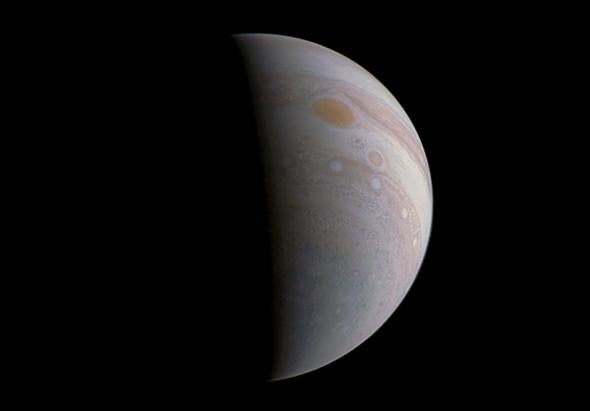On July 5, Jupiter acquired a new moon: NASA’s Juno spacecraft. Launched in 2011, Juno passed by the Earth in October 2013 to pick up some energy and fling itself to Jupiter. Once it arrived, it burned its main engine for over a half hour, slowing enough to place itself into a highly elongated orbit that took it over Jupiter’s poles.
The orbital burn went perfectly, but a potentially serious problem arose. In October, after two complete orbits (each about 54 days apiece), the main engine was scheduled to fire once again. It was supposed to change Juno’s orbit from the initial looping trajectory that took it as close as 4,200 kilometers over Jupiter’s poles to over eight million kilometers out, to the new “science orbit” that was supposed to be only 14 days long.
However, just before the burn, telemetry indicated that a pair of valves had failed to work properly. The orbit reduction maneuver was at first postponed until Dec. 11, but then it was decided to postpone it again until at least the next perijove (closest approach to Jupiter), which is in February 2017. The spacecraft is working, and collecting good data, so engineers decided it would be better to work the problem longer to make as sure as they can that the maneuver will be performed properly.
The image above is from a few hours after the last pass in December, called Perijove 3 (counting the Jupiter orbital insertion in July as 0, the dip over the pole in August Perijove 1, and October Perijove 2). It shows the south pole of Jupiter to the bottom, and from this vantage we’re looking “up” at the Great Red Spot (which is located at a latitude of about 22° south of Jupiter’s equator). The smaller red storm to the lower right is called Oval BA (no relation), but it’s hardly small: It’s about the same diameter as Earth! It formed in 2000 when three smaller storms merged.
The image was processed by master planetary photographer Damian Peach, and it’s so, well, odd. Jupiter orbits the Sun in roughly the same plane as Earth, and its rotational axis is pretty much perpendicular to that plane. That means, from Earth, we tend to be looking down on Jupiter’s equator, with the belts and zones stretching across horizontally. From this angle everything is tilty; it’s a view we cannot get from Earth. If you want to see Jupiter this way, you have to go there.
Which is another reason Juno is so cool. Another Juno image Peach put together from the raw data graced the Astronomy Picture of the Day site recently as well.
This last pass of Jupiter by Juno was the first to take gravity data. One of the main purposes of the Juno mission is to map the interior of Jupiter. As it passes very close to the planet, the layers of material beneath the surface of the planet pull on the spacecraft differently, affecting its orbital trajectory minutely. These changes can be used to determine the density of those layers, which in turn reveals the internal structure of Jupiter.
Weirdly, it’s not clear if Jupiter has a distinct core or not; different physical models for how it formed yield different results. Juno may be able to help scientists determine which is correct. In the meantime, Juno will pass through Jupiter’s intense magnetic field, returning information about that as well.
Hopefully, over the next few weeks scientists and engineers will be more confident they can put Juno into the correct science orbit. Until then, it’s still doing good work, and we can enjoy the literally unearthly view.
